Share this
at-home blood collection for laboratory testing: how it works
by Neoteryx Microsampling on Jun 22, 2020 9:00:00 AM
Telehealth has been around for a few years, but really took off in early 2020, as more people became interested in at-home blood collection devices and kits. Kits can allow people to collect their own blood samples at home for mailing directly to a laboratory for blood test analysis.
With Mitra® microsampling devices you use a simple finger-stick method with a lancet to produce a drop of blood. That absorbs onto the VAMS® tips of a Mitra® device. No phlebotomist, no needle in the arm, or glass vials are needed!
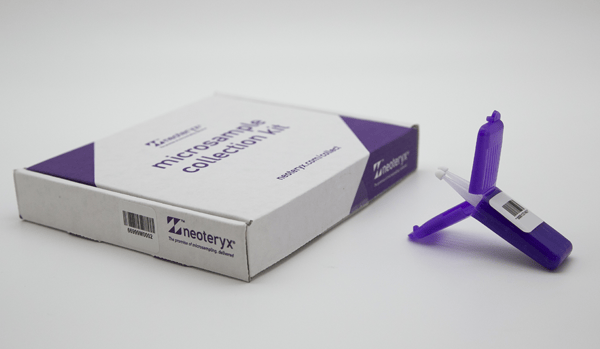
Here we show you how to collect a blood sample at home with a Mitra Blood Collection Kit. Once you see how easy it is, you will understand why more people prefer to manage their own blood sampling using remote kits whenever possible.
With Mitra, anyone can collect their own blood anywhere, anytime. Patient-centric sampling at home reduces anxiety for people wishing to avoid exposure to contagions in clinical settings, and also for those who fear needles and traditional blood draws.
Here is what one mother of a pediatric patient had to say about patient-centric sampling:
“We use the blood collection kit at home for our son, who is a kidney transplant recipient. It saves us time and unnecessary trips to the clinic. The kit has easy instructions, a finger-prick lancet and supplies to collect the samples. We use the shipping envelopes included in the kit to mail the samples to our son’s care provider.”
Ready to get started?
Step #1: You Receive the Mitra Blood Collection Kit
A doctor, laboratory, or research study coordinator ships a Mitra Blood Collection Kit to you at home or arranges for you to pick up the kit at a designated clinic or other site. The kit includes simple instructions, Mitra microsampling device, and the supplies you need to collect your blood sample./Mitra_Media%20Library%20Images%20(March-April%202023)/mitra-clamshell-kit-closed.webp?width=850&height=494&name=mitra-clamshell-kit-closed.webp)
Step #2: Open Your Kit and Get Set Up for Blood Collection
When you open your kit, you’ll find easy-to-follow instructions for collecting a blood sample. Everything you need is in the box, including 2-4 Mitra devices in a protective cartridge and a resealable silver foil bag, along with a packet of desiccant to keep your sample dry during shipping.
/2024%20Mitra%20KIT%20Images%20(approved)/Mitra%20Kit%20Images%20FY24,%20RUO/2-sampler-clamsehll-open-kit-with-foil-bag.png?width=834&height=556&name=2-sampler-clamsehll-open-kit-with-foil-bag.png)
Also included in your kit are a mailing envelope, bandages, gauze, and lancets that you will use to prick your finger to collect a drop or two of blood.
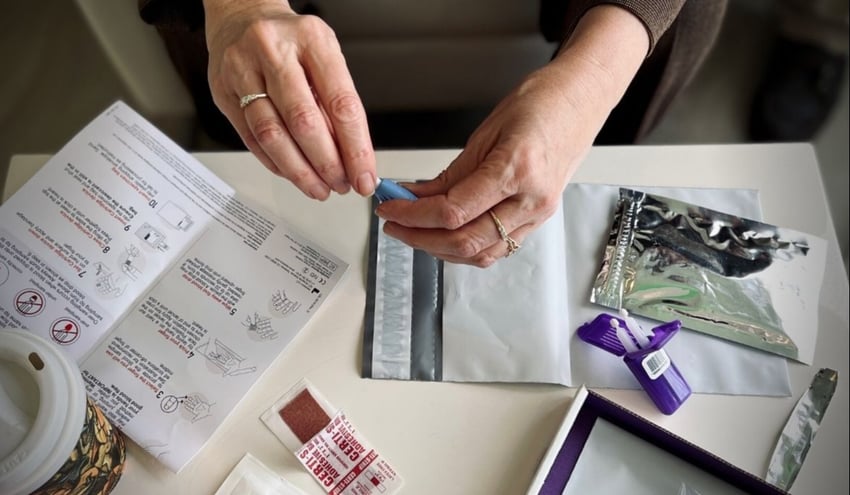
Step #3: You Collect Your Blood Sample Using the Mitra Device
Once you are set up with the supplies nearby, and the Mitra device cartridge is open and ready, use a lancet to prick your finger and gather a drop of blood. (Be sure to leave the Mitra devices inside their protective cartridge—no need to remove them.)
Do you need extra guidance before you start? Watch a video tutorial!
You can view videos from Neoteryx for a quick walk-through of the blood collection process. The steps are easy, but you must follow the instructions carefully to ensure you collect a high-quality sample that is suitable for lab testing.
Tip: Warm hands have better blood flow! Wash your hands in warm water and hold onto a heating pad or microwaveable hand-warmer for a few minutes before the blood collection event. Rubbing your hands together also helps warm them up and get the blood flowing!
Step #4: Absorb a Drop of Blood on the Tips of the Mitra Devices
Once you prick your finger and the blood drop appears, use the medical wipe/gauze provided in the kit to wipe away that first drop. As soon as the second blood drop forms, hold the absorbent sponge tip of the device over the drop. Lower the tip gently onto the drop of blood and watch it absorb into the white sponge tip. This will happen in seconds. (Don’t apply pressure—avoid pressing down on your finger, as this stops blood flow.)
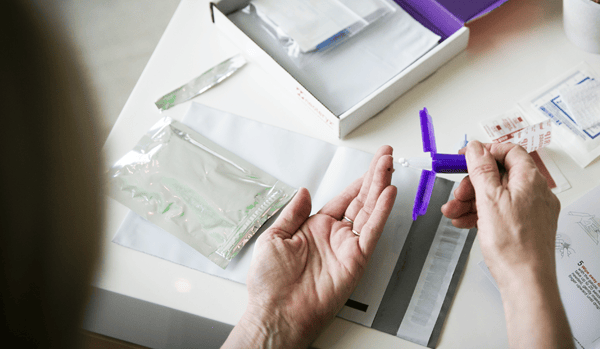
As soon as the first VAMS tip on your Mitra device is properly filled, count two seconds and remove from the blood drop. Lower the second VAMS tip onto the drop of blood and fill that one. (Some patients receive two tips, while others receive four tips. It depends on what type of lab testing will be done at the lab.)
Your instructions (and the animated video tutorial) will illustrate what an under-filled tip looks like, and what an over-filled tip looks like, so you know how to fill the tip correctly.
Step #5: Package Up Your Blood Sample for Shipping to the Lab for Testing
Once you have filled each device tip with your blood sample, you will close up the device cartridge and let it dry for a few hours. Lab testing is performed on a dried blood sample. Once dried, you will place the cartridge inside the resealable silver foil envelope with the drying desiccant pouch, which will go inside a mailing envelope (included in your kit).
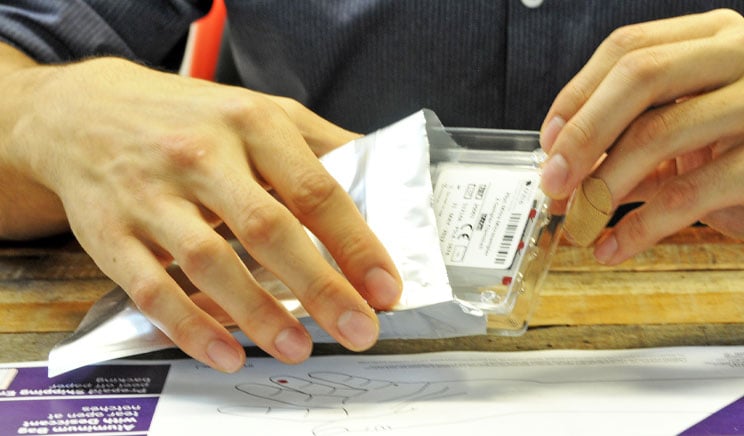
Step #6: The Lab Processes Your Blood Sample
Mitra microsampling is used in research labs and certified Clinical Laboratory Improvement Amendments (CLIA) labs that are “microsampling-ready” for high-quality testing. Once your sample arrives at the designated lab, they process and analyze it.
How do they keep track of your sample? The Mitra microsampling device in each kit has a unique barcode ID number on it. This is so that the lab can keep track of exactly whose sample they are processing. Your care provider, study manager or trial coordinator receives your lab test data linked to that same unique barcode.
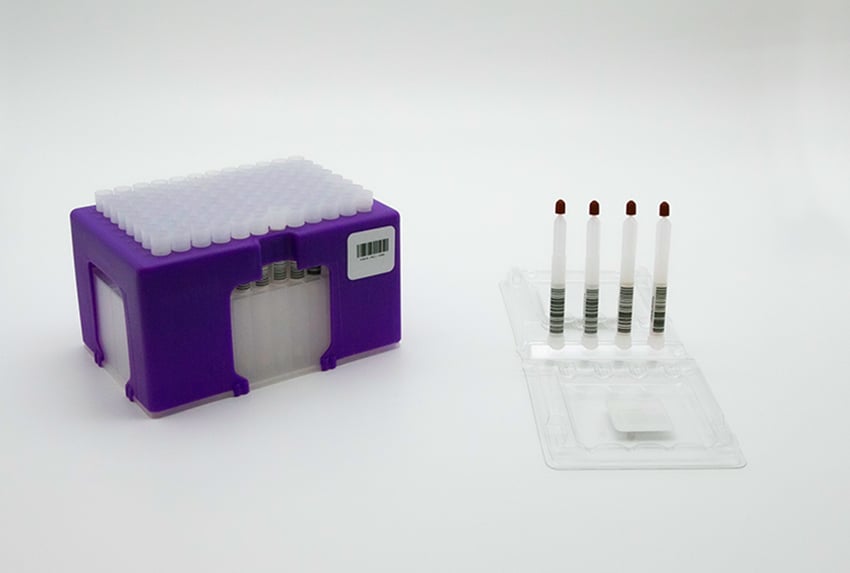
A Drop of Blood from At-Home Blood Collection with Mitra Yields Big Data
How can a drop or two of blood from your fingertip provide enough information for testing, since clinics and labs typically take several vials of blood from a blood draw in the vein of your arm?
Labs don’t actually need full vials of blood for most types of tests. Except in rare cases or special blood panel tests, only a small fraction of blood from each vial is typically used for testing. The remainder of the blood sample in a vial usually is not needed and goes to waste.
Blood-based tests using Mitra and VAMS as the sample input are an advancement on a well-established blood collection method called “dried blood spot” or “DBS.” For DBS, some labs ask you to transfer a drop of blood from your fingertip onto a tiny circle on a “DBS card” made of filter paper. While a DBS card seems like a simple way to collect blood, it doesn’t always deliver a high-quality blood sample.
It can be tricky to transfer the right amount of blood onto that tiny circle on a DBS card, so some cards may not furnish enough blood specimen for accurate testing.
That is where Mitra and VAMS come in. The VAMS tip on the Mitra device is designed to absorb a scientifically precise volume of capillary blood for consistently accurate lab testing.
As shown in hundreds of published studies, Mitra and VAMS have helped scientists consistently meet rigorous standards of reliability and validity.
Many research scientists and labs prefer Mitra with VAMS for high-quality blood samples. They particularly value the fact that several independent publications show that Mitra samples remain stable without any temperature control when stored or shipped through the mail—even from remote locations halfway around the world where refrigeration isn't available.
The Mitra samples are easy to process in the lab—for viral antibody testing, hormone testing, RNA/DNA testing, therapeutic drug monitoring, wellness or fitness testing, and more.
Mitra microsampling devices and Mitra Microsample Collection Kits can be purchased by healthcare providers, researchers and laboratories for shipping out to rural patients, clinical trial participants and isolated community members—virtually anyone, anywhere who can benefit from remote microsampling.

Share this
- Microsampling (206)
- Research, Remote Research (119)
- Venipuncture Alternative (105)
- Clinical Trials, Clinical Research (83)
- Mitra® Device (73)
- Therapeutic Drug Monitoring, TDM (51)
- Dried Blood Spot, DBS (39)
- Biomonitoring, Health, Wellness (30)
- Infectious Disease, Vaccines, COVID-19 (24)
- Blood Microsampling, Serology (23)
- Omics, Multi-Omics (21)
- Decentralized Clinical Trial (DCT) (20)
- Specimen Collection (18)
- Toxicology, Doping, Drug/Alcohol Monitoring, PEth (17)
- Skin Microsampling, Microbiopsy (14)
- hemaPEN® Device (13)
- Preclinical Research, Animal Studies (12)
- Pharmaceuticals, Drug Development (9)
- Harpera Device (7)
- Industry News, Microsampling News (5)
- Antibodies, MAbs (3)
- Company Press Release, Product Press Release (3)
- Environmental Toxins, Exposures (1)
- July 2025 (1)
- May 2025 (1)
- April 2025 (2)
- December 2024 (2)
- November 2024 (1)
- October 2024 (3)
- September 2024 (1)
- June 2024 (1)
- May 2024 (1)
- April 2024 (4)
- March 2024 (1)
- February 2024 (2)
- January 2024 (4)
- December 2023 (3)
- November 2023 (3)
- October 2023 (3)
- September 2023 (3)
- July 2023 (3)
- June 2023 (2)
- April 2023 (2)
- March 2023 (2)
- February 2023 (2)
- January 2023 (3)
- December 2022 (2)
- November 2022 (3)
- October 2022 (4)
- September 2022 (3)
- August 2022 (5)
- July 2022 (2)
- June 2022 (2)
- May 2022 (4)
- April 2022 (3)
- March 2022 (3)
- February 2022 (4)
- January 2022 (5)
- December 2021 (3)
- November 2021 (5)
- October 2021 (3)
- September 2021 (3)
- August 2021 (4)
- July 2021 (4)
- June 2021 (4)
- May 2021 (4)
- April 2021 (3)
- March 2021 (5)
- February 2021 (4)
- January 2021 (4)
- December 2020 (3)
- November 2020 (5)
- October 2020 (4)
- September 2020 (3)
- August 2020 (3)
- July 2020 (6)
- June 2020 (4)
- May 2020 (4)
- April 2020 (3)
- March 2020 (6)
- February 2020 (3)
- January 2020 (4)
- December 2019 (5)
- November 2019 (4)
- October 2019 (2)
- September 2019 (4)
- August 2019 (4)
- July 2019 (3)
- June 2019 (7)
- May 2019 (6)
- April 2019 (5)
- March 2019 (6)
- February 2019 (5)
- January 2019 (8)
- December 2018 (3)
- November 2018 (4)
- October 2018 (7)
- September 2018 (6)
- August 2018 (5)
- July 2018 (8)
- June 2018 (6)
- May 2018 (5)
- April 2018 (6)
- March 2018 (4)
- February 2018 (6)
- January 2018 (4)
- December 2017 (2)
- November 2017 (3)
- October 2017 (2)
- September 2017 (4)
- August 2017 (2)
- July 2017 (4)
- June 2017 (5)
- May 2017 (6)
- April 2017 (6)
- March 2017 (5)
- February 2017 (4)
- January 2017 (1)
- July 2016 (3)
- May 2016 (1)
- April 2016 (2)


Comments (5)